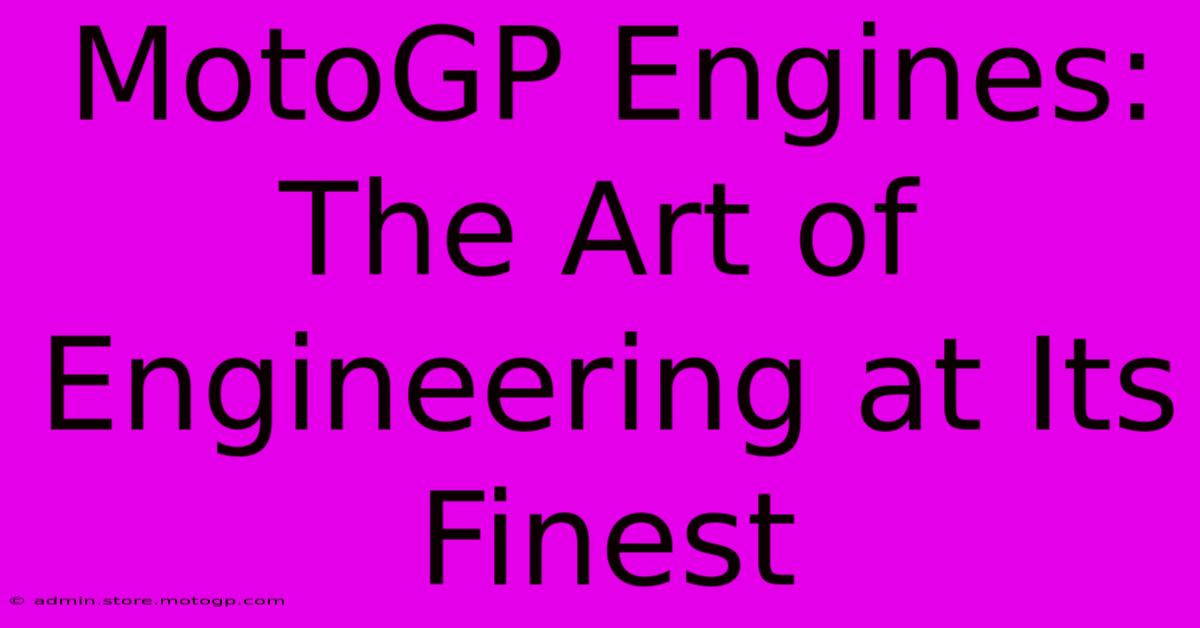MotoGP Engines: The Art Of Engineering At Its Finest

Table of Contents
MotoGP Engines: The Art of Engineering at Its Finest
MotoGP. The name conjures images of screaming engines, breathtaking speeds, and the pinnacle of motorcycle racing. But behind the drama and spectacle lies a marvel of engineering: the MotoGP engine. These aren't just engines; they're meticulously crafted masterpieces, representing the absolute forefront of internal combustion technology. This article delves into the intricacies of these powerhouses, exploring the technology, regulations, and sheer artistry involved in their creation.
The Heart of the Beast: Engine Specifications
MotoGP engines are a testament to innovation. Currently, the class utilizes four-stroke, 1000cc prototypes. This seemingly simple specification belies the incredible complexity within. These aren't mass-produced units; each engine is a bespoke creation, honed to extract maximum performance within the strict regulations imposed by the FIM (Fédération Internationale de Motocyclisme).
Key Features Driving Performance:
- High RPM Capabilities: These engines are designed to rev incredibly high, often exceeding 16,000 RPM. This requires incredibly strong and lightweight materials, precise tolerances, and advanced lubrication systems.
- Lightweight Design: Every gram counts in MotoGP. Engine components are meticulously engineered to be as light as possible without sacrificing strength or reliability. This contributes to faster acceleration and improved handling.
- Sophisticated Electronics: Modern MotoGP engines rely heavily on sophisticated electronics. Engine Control Units (ECUs) manage fuel injection, ignition timing, and traction control, optimizing performance in real-time. This is crucial for maximizing grip and preventing wheelspin, especially during acceleration and corner exits.
- Aerodynamic Integration: The engine is not just a standalone component; it's integrated into the overall aerodynamic design of the motorcycle. Airflow around the engine is carefully managed to maximize cooling efficiency and minimize drag.
- Material Science Advancements: The use of cutting-edge materials, such as titanium, carbon fiber, and magnesium alloys, is paramount. These materials offer superior strength-to-weight ratios, crucial for maximizing performance.
The Regulatory Landscape: Balancing Performance and Safety
The FIM's regulations play a significant role in shaping MotoGP engine design. These rules are designed to control costs, ensure competitiveness, and promote safety. While specific details change year to year, the overarching goal remains consistent: to create a level playing field while pushing the boundaries of technological innovation. These regulations cover aspects like engine configuration, fuel limitations, and even the number of engines permitted per season.
The Challenge of Compliance:
Meeting these regulations while simultaneously striving for peak performance is a constant challenge for engine manufacturers. Teams employ highly skilled engineers and utilize advanced simulation tools to optimize engine design within the confines of the rulebook. The constant push for improvement leads to continuous evolution, creating a dynamic and exciting environment.
Beyond the Engine: The Holistic Approach
The MotoGP engine is only one part of a much larger system. Its performance is intrinsically linked to other components like the chassis, suspension, and tires. Teams must carefully consider the interplay between all these elements to achieve optimal performance. This holistic approach, considering every aspect of the motorcycle as a single, interconnected unit, is crucial to success.
The Future of MotoGP Engines:
The future of MotoGP engines is likely to involve further advancements in areas such as:
- Hybrid Technology: The incorporation of hybrid systems could offer further performance gains and potentially lead to more sustainable racing.
- Improved Fuel Efficiency: Regulations may push for greater fuel efficiency without sacrificing power. This requires even more sophisticated engine management systems.
- Artificial Intelligence (AI): AI could play a greater role in engine development and real-time performance optimization.
The MotoGP engine is a testament to human ingenuity and the relentless pursuit of performance. It’s a symbol of advanced engineering, pushing the boundaries of what’s possible within the framework of stringent regulations. The competition between manufacturers ensures continuous innovation, promising even more exciting and technologically advanced engines in the years to come.

Thank you for visiting our website wich cover about MotoGP Engines: The Art Of Engineering At Its Finest. We hope the information provided has been useful to you. Feel free to contact us if you have any questions or need further assistance. See you next time and dont miss to bookmark.
Featured Posts
-
Unlocking Austins F1 Secrets Your Go To Map
Feb 19, 2025
-
Conquer The Course Austin Sprint Race Time Breakdown
Feb 19, 2025
-
Cota Lot H A Step By Step Guide
Feb 19, 2025
-
Cota Qualifying Learn From The Best
Feb 19, 2025
-
Unveiling The Secrets Of The Moto Gp Desmosedici
Feb 19, 2025
